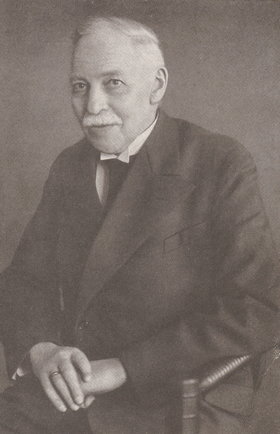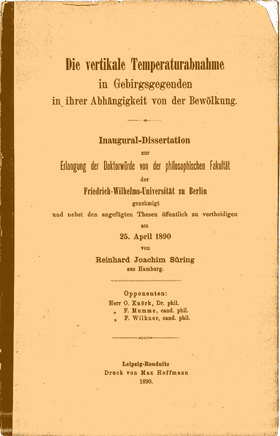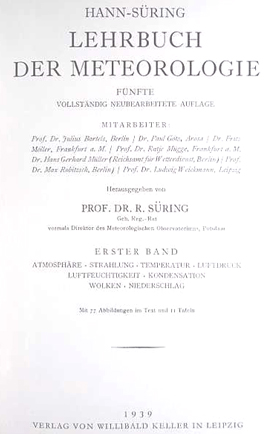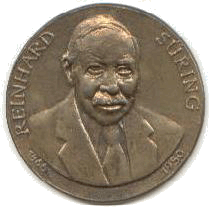 |
| Reinhard Süring (1941) |
 |
| Thesis on the Vertical Decrease of Temperature in Mountainous Regions and its Dependence on Cloud Conditions (1890) |
 |
| Textbook of Meteorology |
 |
| Reinhard Süring Medal |
April 1945: World War II was in its final phase and fighting was going on around Berlin. On 23rd April, the front reached the suburbs of Potsdam. The staff of the Meteorological Observatory on the Telegrafenberg in Potsdam were withdrawn on 20th April, and the last remaining men conscripted to the military for the "Final Battle". The last meteorological observation took place on 20th April at 7 a.m.. On the morning of 24th April the departing German troops blew up the bridges over the Havel, thus cutting off the Telegrafenberg from central Potsdam. But before the bridges were dynamited, the 79-year-old Professor Reinhard Süring had evidently already made his way to the Observatory and recommenced meteorological observations, the first data being recorded during the afternoon of 24th April. From 30th April, observations were made at all three standard observation times, in other words, before the capitulation of German forces on 8th May.
Who was this Reinhard Süring?
He was born on 15th May 1866 and studied mathematics and natural sciences in Göttingen, Marburg and Berlin. At 21, still a student, he became an assistant at the Imperial Physical-Technical Institute. He was already interested at that time in the air's upper layers. He obtained his doctorate in the year 1890 with a thesis on the Vertical Decrease of Temperature in Mountainous Regions and its Dependence on Cloud Conditions. In the same year he started as an Assistant at the Prussian Meteorological Institute in Berlin, and with the foundation of the Meteorological-Magnetic Observatory in Potsdam in 1892, he was also employed there.
The first official weather observation of the Potsdam long-term meteorological series was carried out on New Year's Day 1893 by R. Süring.
Unintentional world record holder
He gained worldwide attention with the record balloon ascent he carried out with Professor Berson for scientific purposes on 31st July 1901. They reached a height of 10,800 m in an open gondola. Süring took part in numerous scientific high-altitude balloon ascents between 1893 and 1921.
Director of the Potsdam Meteorological Observatory for 23 plus 5 years
From 1901 Süring was Head of the Storm Department of the Prussian Meteorological Institute. In 1909 he was appointed Director of the Potsdam Meteorological Observatory, which he headed with international acclaim until his retirement in 1932. But that was not the end. After ensuring that the long-term observation series survived almost unbroken through the war-time events described above, he was again Director of the Observatory from April 1945 until March 1950. On the 29th December of that year Reinhard Süring died in Potsdam, a few months before the end of his 85th year of age.
One of the most important meteorologists of the first half of the 20th Century
Under his direction the Observatory became a cloud research centre of international standing. He was one of the most significant German meteorologists of the first half of the 20th Century. His scientific achievements centred around research into the upper atmosphere and in cloud and radiation research. The standard work for generations of meteorology students was Hann & Süring's Textbook of Meteorology.
Awards associated with his name
The German Meteorological Association today awards the Reinhard Süring Medal, a tradition which was introduced by the Meteorological Association in the 1960's.
An index of Reinhard Süring's 154 publications can be found in the "Zeitschrift für Meteorologie" (Journal for Meteorology), Volume 5, Issue 5/6 (1951), Berlin.





